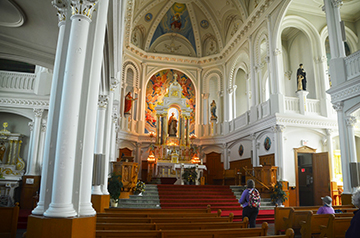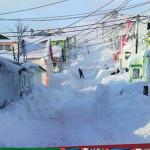Eastern Canada’s confusing geography has us looking at the map every night to see exactly where we’re going.
We’re traveling down the St. Lawrence River, which means we’re heading northeast, but we aren’t cruising as the crow flies.

Our ship, Adventure Canada’s Ocean Endeavor, is zigzagging its way from Quebec City to St. John’s, Newfoundland.
And then suddenly, we’re in France — or perhaps more accurately, on French soil.

We dock at Saint Pierre, the only town on the island of the same name and its neighbor island, Miquelon (St-Pierre et Miquelon), which sit off the southern coast of Newfoundland. The islands are an “overseas collectivity” that belongs to France, like French Polynesia and San Martin in the Lesser Antilles.
How Saint Pierre and Miquelon became the last piece of New France in Canada not ceded to Britain is a story that includes many contentious encounters between the French and British that occurred over a couple of centuries. The conflicts generally didn’t end well for the French — except for these islands, which the British returned to France in the 1814 Treaty of Paris.

Today the residents speak French, use Euros, and pay taxes to and receive subsidies from France.
The much smaller of the two islands, Saint Pierre is home to most of the 6,000-plus residents. We begin our visit there with a cross-county hike through rolling hills, rocky countryside and spongy, verdant meadows dotted with glacial ponds and the season’s earliest wildflowers.
At the end of the trail, we discover a movie-worthy deserted beach and a bank of massive boulders — a magnet for the kids and the more agile adults.
Those who climbed the rocky pile find a 5-foot-tall statue of the Virgin Mary, standing guard over the North Atlantic.
Our bus tour the next morning takes us around the island’s only town, and we learn what it’s like living in an isolated place far from the mother country. Many residents are fisherman and can work only half the year, so they are subsidized during the frigid months by France at about 85 percent of their salaries. And students, who must leave the islands for college, receive money for transportation (there is an airport) and for at least one trip home each year. Free schooling begins at age 2.

On another day, we visit a second town built on French tradition and located on the northwest coast of Cape Breton (Nova Scotia). Cheticamp, population slightly less than 4,000, is “an island of Acadian culture surrounded the British, Irish and Scottish,” our guide says, “but we all get along.”
Acadians are descendants of eastern Canada’s early French settlers and have always been the country’s minority group.
(As an aside, Cape Breton’s population of 98,000 is shrinking, and some are marketing the area as a haven for those who threaten to relocate to Canada if Donald Trump is elected president. “Yes, the weather is cold,” the pitch goes, “but we have free health care, beautiful scenery, and we welcome all kinds.”)

Cheticamp has worked hard to preserve their Acadian culture — the music, art, food, and an annual celebration called Mi-Careme. This tradition is one of partying for one day halfway through Lent as a way to provide relief from the 40 days of somber mood and sacrifice.

Participants, of course, want to remain anonymous; thus arose the custom of donning costumes and masks.
Mi-Careme has, not surprisingly, grown to a week-long celebration, and the town has built Le Centre de la Mi-Careme to educate others about this tradition.
Our day in Cheticamp ends with food, drink and music at the Le Gabriel family restaurant, where we listen to local musicians, and residents and cruise passengers dance into the early evening together.
The Mighty St. Lawrence” cruise, offered by Adventure Canada, has been named by National Geographic as one of its “50 Tours of a Lifetime.” Visit adventurecanada.com.
For more photos, visit facebook.com/elouise.ondash.
E’Louise Ondash is a freelance writer living in North County. Tell her about your travels at [email protected]




